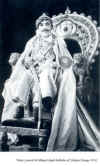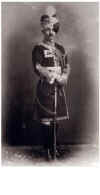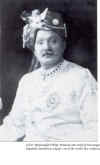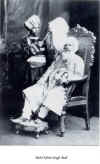|
Page 2 of 3
MAHARAJAS AT THE
LAFAYETTE STUDIO
(cntd)
by
Kavita Devgun
Major General
Maharajdhiraj Sir Bhopal Singh of Udaipur
|
 When Maharajdhiraj Sir Bhopal Singh Bahadur of Udaipur visited
London ion 1933 for his knighthood, he visited the Lafayette
Studio and had many photographs taken against different backdrops
and in various dresses. When he was 16, the Maharajdhiraj
contracted tuberculosis and a disease called Pott’s Curvature of
the Spine. Unwilling to consult British doctors, the palace
medical supervisors allowed him to continue riding with disastrous
results. The disease left him paralysed waist down, confined to a
wheelchair and without heirs.
When Maharajdhiraj Sir Bhopal Singh Bahadur of Udaipur visited
London ion 1933 for his knighthood, he visited the Lafayette
Studio and had many photographs taken against different backdrops
and in various dresses. When he was 16, the Maharajdhiraj
contracted tuberculosis and a disease called Pott’s Curvature of
the Spine. Unwilling to consult British doctors, the palace
medical supervisors allowed him to continue riding with disastrous
results. The disease left him paralysed waist down, confined to a
wheelchair and without heirs.
|
Nawab of Bhopal
|

The Nawab of Bhopal or, more appropriately, Major General
H.H.Sikander Saulat Iftikar Ul Mulk Nawab Hafiz Sir Muhammad
Hamidullah Khan Bahadur. was destined to succeed Jinnah as the
second Governor General of Pakistan but was forced by pressures of
his responsibilities in India to forego the honour when Jinnah
died suddenly. His photograph was taken on his visit to England in
1925 along with his mother, who was trying to assure his
succession with the British government.
|
Sir Ranjitsinhji Vibhaji, popularly known as Ranji---one
of the world’s best cricketers
|
 The portrait of Sir Ranjitsinhji Vibhaji bears remarkable
resemblance to his descendent, cricketer Ajay Jadeja. Ranjitsinhji,
like his legatee, is known for his cricketing skills and it was
after him that the Ranji trophy was instituted. His photograph
captures him in his ceremonial dress and sword, with an emerald
and diamond necklace embedded with 277 carats of the best emeralds
in the world. Royalty at its opulent best.
The portrait of Sir Ranjitsinhji Vibhaji bears remarkable
resemblance to his descendent, cricketer Ajay Jadeja. Ranjitsinhji,
like his legatee, is known for his cricketing skills and it was
after him that the Ranji trophy was instituted. His photograph
captures him in his ceremonial dress and sword, with an emerald
and diamond necklace embedded with 277 carats of the best emeralds
in the world. Royalty at its opulent best.
|
Baba Khem Singh Bedi, the fourteenth spiritual head
of the Sikhs

One of the rarest pictures of the selection is that of Baba
Khem Singh Bedi, who was the fourteenth spiritual head of the
Sikhs by direct descent from the founder of their faith, Guru
Nanak. He did much to maintain the martial spirit of the Sikhs by
encouraging recruits to join the various Sikh regiments. He gave
away liberally for the purpose of education, and at least fifty
schools were opened for boys and girls in Punjab with his help.
In 1883, on the occasion of his daughter’s wedding, he
donated Rs. 300,000 to religious and charitable causes. Half this
amount was used for establishing a college in Rawalpindi. This
photograph was taken in 1902 when Baba Bedi was invited to England
as an official representative of the Punjab at the Coronation of
King Edward Vll, (Image dated 1902) |
next
page
Disclaimer
Copyright
© 2000 - 2001 [the-south-asian.com]. Intellectual Property. All rights reserved.
Home |
|



